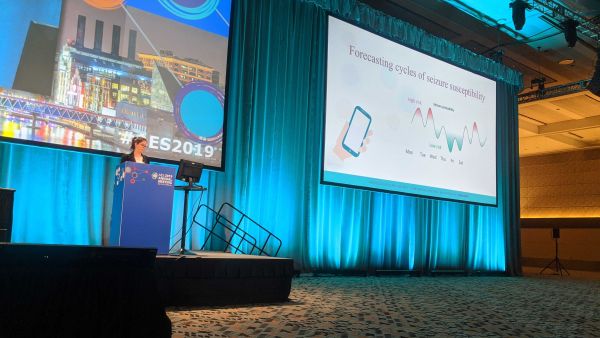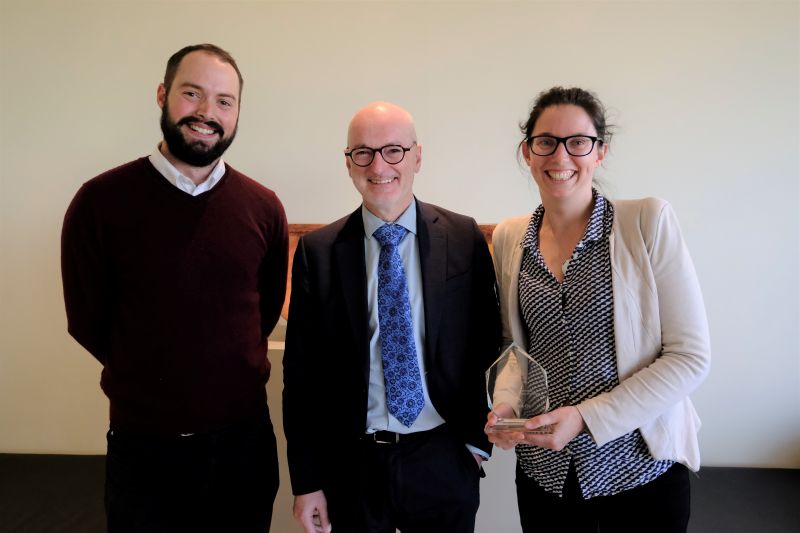5 Minute read
During her PhD, Dr Pip Karoly noticed new cycles for seizures in epilepsy sufferers – including weekly, monthly and even longer cycles. Since then, she’s learnt to code. And she is now working in a team at Seer Medical to create a seizure tracking and forecasting app – a concept she outlined during her PhD.
Life after graduate research: Dr Pip Karoly
In what area of research was your PhD?
Clinically applied neuroscience.
What were you trying to discover in your PhD?
I was working in a team that was trying to develop new methods for predicting seizures for people with epilepsy. I was lucky because I had access to existing data sets for analysis. I used a long-term data set of brain implant recordings from a human clinical trial in Melbourne. And a large set of mobile seizure diaries from some collaborators in the USA.
In some cases, we had thousands of seizures per person. With that information, we developed models that would determine seizure likelihood based on certain factors. The way that a weather forecast predicts the chance of rain.
Previously, we and other researchers had wanted to predict seizures in a definitive fashion. During this time, however, we shifted our thinking as a team. We became focused on providing a good estimation of seizure probabilities, rather than certain outcomes.
What were the main findings of your PhD?
One of the big discoveries we made was that we noticed new cycles for seizures in individuals. We’ve known for a long time that circadian cycles correlate with seizures. But we didn’t know how prevalent longer cycles are too. We noticed weekly, monthly and even longer cycles in individuals. This was fascinating and we needed the large data sets to realise this. Why these cycles exist still remains somewhat of a mystery.
I also included in my report a proof of concept for a seizure tracking and forecasting app. This is what I am working on now.
Why did you do a PhD?
My interest in this area was sparked by my final-year masters Endeavour project here at the University of Melbourne. In these projects, students work in collaboration with government and industry to solve real-world challenges.
Our Endeavour project measured brain activity to convert someone’s intentions into movement of a cursor on a screen, known as a brain-machine interface. It was a really fun and interesting project. And the people I worked with were also working in epilepsy research.
They’d led a brain implantation device trial. And that trial created the data I used for my PhD. So, through Endeavour I met the people who became my supervisors in that final-year project.
Why did you choose to do your PhD at the University of Melbourne?
After my masters, I worked for a year as a research assistant with the people I’d met through the Endeavour project. It was fantastic preparation before diving into my PhD.
Through working as a research assistant, I connected with international researchers and industry professionals. And I knew I wanted to continue to be part of that network, so I didn’t really consider doing my PhD anywhere else.
What was the best part about researching here?
I got to work with world-renowned researchers in and outside of the University. I wouldn’t have made the same contacts at another university.
I also went to the USA for 10 months to continue my research at the University of Pennsylvania. This came about because one of my supervisors, Professor Mark Cook, is connected with a neurologist there. It wasn’t a formal exchange, but they sponsored my visa, nonetheless.
I also got some additional funding through a University scholarship. That’s another thing – you can apply for scholarship top-ups through the University of Melbourne for research-related travel.

How has your PhD shaped your current work situation?
Just before I completed my PhD, some of my colleagues (Dr Dean Freestone, Professor Cook and George Kenley) co-founded the epilepsy diagnostic company Seer Medical. And I was on board with them from the start. Since then I’ve learnt to become a mobile software developer. Together, we’ve been developing the seizure forecasting app that I outlined in my PhD.
Until very recently I spent half my time at Seer. Now I am based at The Graeme Clark Institute, at The University, but remain a close collaborator with them.
Right now, the Seer app is being used by patients to collect data, including what medications they’re on and information about their seizures. They’re also collecting data via wearable technology including Fitbits. Once we have enough data collected via the app, we’ll create a seizure forecast for them.
In 2019 we won $15,000 as part of the Health Tech Innovation Pitch Challenge. We will use the money to obtain another 200 wearable devices, ie Fitbits. Meaning we can widen the number of participants using the app. It’ll also make it easier for us to commercialise the product. We want to eventually partner with pharmaceutical and medical device companies (while keeping the app free for users with epilepsy). Because seizure forecasting could lead to improvements in patient therapy.

What do you wish you’d known before you started your research?
It is such a unique time as you get to have a single-minded focus on something. While it’s challenging, you want to make time to really enjoy that experience. Now that my PhD is over, I’m involved in lots of different activities again which can feel overwhelming.
The opportunity to focus on one specific problem doesn’t come around that often. I underestimated how much I would miss it once it was over.
Learn more
-
Australian Epilepsy Project
The Australian Epilepsy Project is competing for Medical Research Future Fund support to improve epilepsy diagnosis throughout Australia.
-
Predicting epileptic seizures, just like the weather
A new tool can predict the likelihood of epileptic seizures, paving the way for a forecasting app that could be used every day.
-
‘Epilepsy seizures’ – The Lancet Neurology podcast
Listen to Professor Mark Cook talk about epilepsy seizure detection and prediction.
-
Reading the body’s electrical signals to treat illness
Researchers are now seeking to record and interpret our own electrical signals to predict symptoms.
First published on 20 March 2024.
Share this article
Keep reading
-
Your study experience
Discover what it's like to be a graduate researcher. Find out about University life, support services, and opportunities for skills development.
-
Explore research areas
Discover your graduate research options at the University of Melbourne.
-
Researching identity construction while building a new life
Franka Vaughan has moved to Melbourne from the UK to complete her PhD. Originally from Ghana in West Africa, Franka is researching identity construction in post-conflict Liberia.
-
Uplifting children's voices: how a PhD can change careers
Dr Katie Lamb talks about life after her PhD. And the perspectives of children and young people who’ve experienced family violence.